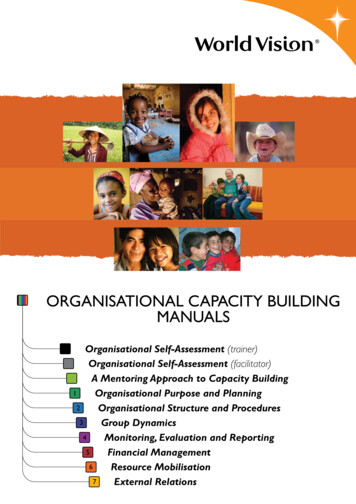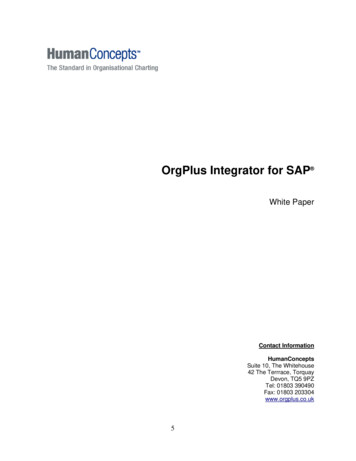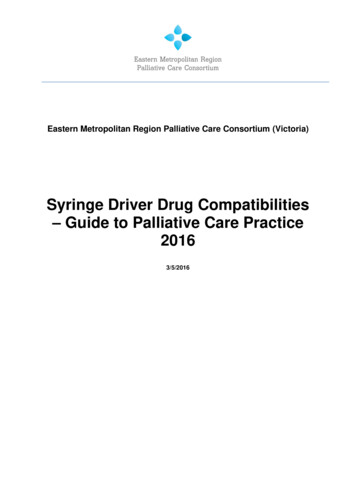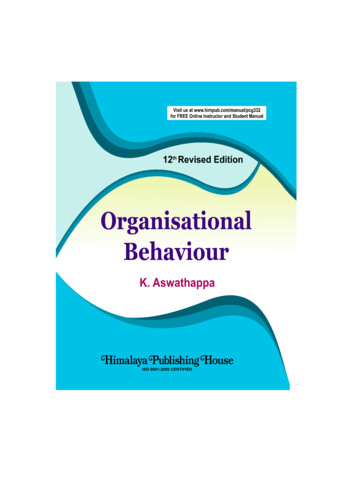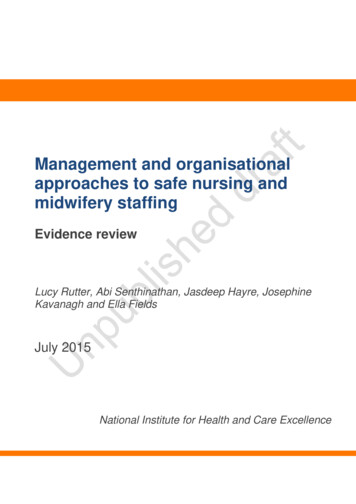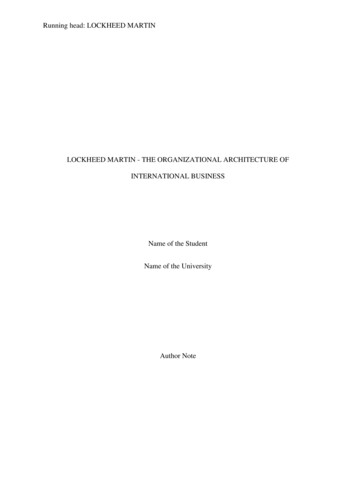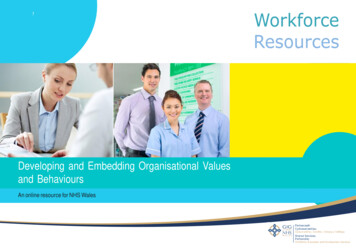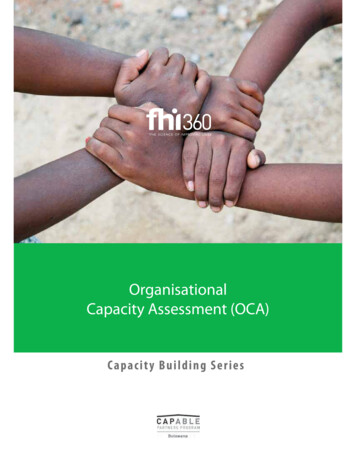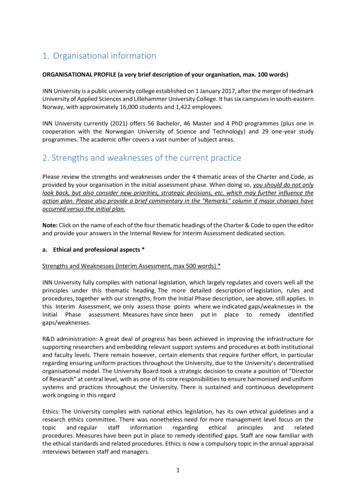
Transcription
1. Organisational informationORGANISATIONAL PROFILE (a very brief description of your organisation, max. 100 words)INN University is a public university college established on 1 January 2017, after the merger of HedmarkUniversity of Applied Sciences and Lillehammer University College. It has six campuses in south-easternNorway, with approximately 16,000 students and 1,422 employees.INN University currently (2021) offers 56 Bachelor, 46 Master and 4 PhD programmes (plus one incooperation with the Norwegian University of Science and Technology) and 29 one-year studyprogrammes. The academic offer covers a vast number of subject areas.2. Strengths and weaknesses of the current practicePlease review the strengths and weaknesses under the 4 thematic areas of the Charter and Code, asprovided by your organisation in the initial assessment phase. When doing so, you should do not onlylook back, but also consider new priorities, strategic decisions, etc. which may further influence theaction plan. Please also provide a brief commentary in the "Remarks" column if major changes haveoccurred versus the initial plan.Note: Click on the name of each of the four thematic headings of the Charter & Code to open the editorand provide your answers in the Internal Review for Interim Assessment dedicated section.a. Ethical and professional aspects *Strengths and Weaknesses (Interim Assessment, max 500 words) *INN University fully complies with national legislation, which largely regulates and covers well all theprinciples under this thematic heading. The more detailed description of legislation, rules andprocedures, together with our strengths, from the Initial Phase description, see above, still applies. Inthis Interim Assessment, we only assess those points where we indicated gaps/weaknesses in theInitial Phase assessment. Measures have since been put in place to remedy identifiedgaps/weaknesses.R&D administration: A great deal of progress has been achieved in improving the infrastructure forsupporting researchers and embedding relevant support systems and procedures at both institutionaland faculty levels. There remain however, certain elements that require further effort, in particularregarding ensuring uniform practices throughout the University, due to the University’s decentralisedorganisational model. The University Board took a strategic decision to create a position of “Directorof Research” at central level, with as one of its core responsibilities to ensure harmonised and uniformsystems and practices throughout the University. There is sustained and continuous developmentwork ongoing in this regardEthics: The University complies with national ethics legislation, has its own ethical guidelines and aresearch ethics committee. There was nonetheless need for more management level focus on thetopicand ndrelatedprocedures. Measures have been put in place to remedy identified gaps. Staff are now familiar withthe ethical standards and related procedures. Ethics is now a compulsory topic in the annual appraisalinterviews between staff and managers.1
Research Data management: Measures have been put in place to remedy identified gaps. TheUniversity has put in place and is implementing a system for life-cycle management of research data,including related support and training arrangements for researchers.Scientific publication: Measures have been put in place to remedy identified gaps. Based onquality organisational development work and the strengthening of research activities in recent years,the University has had an increase in the rate of scientific publication, in both level 1 and level 2publication channels. The academic environments at the University have both increased in size andstrengthened their research competence. This is the result of strategic investments in research groupsand increased focus on strategic recruitment, including international, of employees with solid researchexpertise with regard to both publication and winning of external funding applications. Performancebased allocation of R&D time has contributed to a more targeted use of R&D time and morepublications.The University has local guidelines for Open Access, based on the national goals and guidelines forOpen Access to research articles. A dedicated Open Access website on the University’s web gives staffinformation on both policies and procedures. An Open Access-fund, covering processing charges isavailable to researchers.Remarks (max 500 words)Detailed information and explanation on the implementation of the various Actions in our ActionPlan can be found under Section 3 on Actions in this Interim Assessment.INN University was established 1 January 2018, as the result of a merger between the formerLillehammer University College and Hedmark University of Applied Sciences. Many of the identifiedgaps and related measures in the Charter and Code Action plan have been part of the workof cementing the new institution and harmonising strategies, policies and former practices. The newinstitution is now firmly established. A new rector was appointed on 1 May 2021. The institution is nowentering into a forward-looking phase, moving from consolidating the new institution into developingand enhancing organisational performance. The University is striving for continuous improvement. Wewant to continue to develop a university that delivers high quality in research and education. We wantto continue to develop a competent administration that delivers high quality support services and wewant to be an attractive employer that gives employees the opportunity for professional and personaldevelopment and growth during their time as an employee with us. The University’s overall strategyemphasises that we are a learning organisation that works for innovation and continuousimprovement. This will also characterize the HR strategy in the years to come.b. Recruitment and selection *Strengths and Weaknesses (Interim Assessment, max 500 words) *INN University fully complies with national legislation, which largely regulates and covers well all theprinciples under this thematic heading. The more detailed description of legislation, rules andprocedures, together with our strengths, from the Initial Phase description, see above, still applies. Inthis Interim Assessment, we only assess those points where we indicated gaps/weaknesses in theInitial Phase assessment. Measures have since been put in place to remedy identifiedgaps/weaknesses. Measures are focused towards the four headlines; systems and structure,management training, process efficiency and allocation of resources. More information is includedunder "Comments on the implementation of the OTM-R principles (Internal Review for InterimAssessment)".2
Remarks (max 500 words)Detailed information and explanation on the implementation of the various Actions in our ActionPlan can be found under Section 3 on Actions in this Interim Assessment.c. Working conditions *Strengths and Weaknesses (Interim Assessment, max 500 words) *INN University fully complies with national legislation, which largely regulates and covers well all theprinciples under this thematic heading. The more detailed description of legislation, rules andprocedures, together with our strengths, from the Initial Phase description, see above, still applies. Inthis Interim Assessment, we only assess those points where we indicated gaps/weaknesses in theInitial Phase assessment. Measures have since been put in place to remedy identifiedgaps/weaknesses.Support arrangement for national and international cooperation: Measures have been put in place toremedy identified gaps. All researchers are routinely informed of mobility opportunities and relatedprocedures through the annual staff appraisal interviews. Harmonised support arrangements are inplace at faculty level.Annual staff appraisal review: Measures have been put in place to remedy identified gaps. Allmanagers document annual performance appraisal interviews and career development plans forstaff. This is ensured through procedures in the “Management Portal” and is included in themanagement yearly planning wheel. The University has established a “Management Portal” on theorganisation’s intranet where all relevant procedures, forms, etc. are easily available tomanagers. Competency management and employee development is part of the University’s regularmanagement training.Career development: Measures have been put in place to remedy identified gaps. Qualification andcareer development has become a very important topic for the University and there is ever-increasingfocus on the issue. The University has been working on a new “Competence, career and recruitmentpolicy” and the work is still ongoing, with the aim of developing a uniform/unified employer policy.The current policy will be superseded by the new policy but stays applicable until the new policy isapproved. A career paths- and qualifications framework is available and communicated to all academicstaff.Women in academic positions: Measures have been put in place to remedy identified gaps. TheUniversity launched a specific “Action Plan for Equality and Diversity” in May 2020. This action planhas raised awareness among staff and managers, in addition to the already established proceduresand routines. Management meetings routinely analyse the overall person-years and the proportion ofwomen in general and in top academic positions in particular. The University has reintroduced «searchand find» committees for aiding targeted recruitment. The procedure is included as a routine withregard to recruitment. The HR department has had internal seminars and trainings to increaseknowledge on this topic.Translated information for international staff: Measures have been put in place to remedy identifiedgaps. Information regarding working conditions, employee rights and HSE are available in Englishlanguage.3
IPR: Measures have been put in place to remedy identified gaps. The University Board approved theUniversity’s Intellectual Property Rights policy in 2019. The policy, together with related informationand procedures, is available to all employees on the University’s internal web.Remarks (max 500 words)Detailed information and explanation on the implementation of the various Actions in our ActionPlan can be found under Section 3 on Actions in this Interim Assessment.d. Training and development *Strengths and Weaknesses (Interim Assessment, max 500 words) *INN University fully complies with national legislation, which largely regulates and covers well all theprinciples under this thematic heading. The more detailed description of legislation, rules andprocedures, together with our strengths, from the Initial Phase description, see above, still applies. Inthis Interim Assessment, we only assess those points where we indicated gaps/weaknesses in theInitial Phase assessment. Measures have since been put in place to remedy identifiedgaps/weaknesses.Career development: Measures have been put in place to remedy identified gaps. Qualification andcareer development has become a very important topic for the University and there is ever-increasingfocus on the issue. The University has been working on a new “Competence, career and recruitmentpolicy” and the work is still ongoing, with the aim of developing a unified employer policy. TheUniversity is currently working on a new uniform/unified employer policy. The current policy will besuperseded by the new policy but stays applicable until the new policy is approved. A career path- andqualifications framework is available and communicated to all academic staff.Career guidance is now included as a recurring topic in the annual internal seminar for youngresearchers. The University has put a lot of focus on integrating younger researchers in active researchgroups, e.g. by including this as a topic in the training course in research management. The R&Dcommittee reports annually to the Board of Directors on this with regard to the participation of PhDcandidates in research groups. There is a regular offer of training courses for researchers on the topicsof research management and management/leadership of research groups, which also raises this issue.The result of these efforts, and the heightened focus on career development through the annual workplans is an increase in younger researchers in research groups.Mentoring: Measures have been put in place to remedy identified gaps. A system is now in place thatsystematically assesses when and how to link mentors and supervisors to individuals’ career plans. TheUniversity thus has a system for pairing mentors and mentees, but this is done on a case-to-case basis.We do not yet have a full-fledged mentoring programme with a pool of mentors and a standardisedset of procedures. An analysis is ongoing to determine whether and in what form such a potentialmentoring programme could be introduced at the University. One idea is to include thesupervision/mentoring of young researchers as part of the job descriptions of all seniorresearchers. There is already a clear expectation that they do this, but including it in job descriptionswould formalise the expectation.PhD supervision: Workshops and meetings are routinely organised for PhD supervisors. Thesupervisors are obliged to attend the yearly PhD day. This day gathers the University’s PhD candidates4
and Postdocs for a joint day of information and experience sharing; including such seminars as“Motivational seminar for early career researchers” and other relevant talks and seminars.Remarks (max 500 words)Detailed information and explanation on the implementation of the various Actions in our ActionPlan can be found under Section 3 on Actions in this Interim Assessment.e. Have any of the priorities for the short- and medium term changed? (max 500 words)The following University initiatives and projects supports and provides follow-on from current Actionsin our Action Plan.International research projects and networks: To strengthen the University’s opportunitiesin EU programmes, we are planning a more structured initiative and measures toincrease revenues from the EU programmes. During 2021, several measures were implemented inorder to increase our EU project portfolio and achieve the goal of doubling EU revenues by 2025.Research groups with the potential to be successful applicants in EU programmes will receiveadditional funding. The allocated funds will be significant enough to free up researchers and researchgroups to develop networks, develop scientific environments, write applications, have workshopsand international trips/contact. The support is managed by the Pro-rector for Research with the R&DCommittee as an advisory body. The research groups will be able to apply for the funds according togiven criteria with effect from 2022. The administrative capacity to follow up onthis EU initiative will also be strengthened with an EU adviser resource.Young researchers and internationalisation: In order to strengthen and develop theUniversity’s research culture and promote internationalisation on a long term basis, the ResearchDepartment will develop a two-year programme for competence and career development for youngresearchers. The target group is employees who have achieved first competence in scientific or artisticdevelopment work) during the last five years. The programme is open to all faculties and applicants areadmitted after assessment of individual applications. A committee assesses the applications;applicants are nominated by the R&D Committee and approved by the Pro-rector for research.Participation in the programme involves being given time for research, participation in jointgatherings, mentoring and shorter stays abroad / mobility and international networking. Together,these elements will contribute and lead to each participant developing an application for an ERCStarting Grant or for the Norwegian Research Council's Pioneering Research or other relevant grants.The programme is intended to develop the University’s future research leaders who, through theirinternational research expertise and network, will contribute to the development of interdisciplinaryand international research projects. During 2021, the programme has been developed, incollaboration between the Research Department and HR, as a pilot withapproximately eight participants for the period 2022-2024.Research administration and research support - Development of a research support cluster at INNUniversity. The University has launched a project to improve research administration andsupport. The University’s overall vision is Stronger together with the core values involving, innovativeand truth seeking. Furthermore, our research strategy has three main goals that will support theUniversity's ambition: - Increase research production - Strengthen competence - Streamline researchsupport. The need to streamline, modernise and professionalise research support is based on severalelements, where the two most important are 1) the changes that are taking place in the universitysector within open research and 2) the need for increased collaboration within the organisation wherewe have a diverse and dispersed research administration. In future, research and research projects5
funded by the Norwegian Research Council and the EU are expected to have a greater focus on impact/ benefit and an interdisciplinary approach to solving the research questions. The researchadministrative support functions are important tools for achieving this. There will also be a need forincreased specialised competence within all elements of the research administration, including libraryservices related to research. There is a need for better communication, systematic competencedevelopment and increased exchange of experience for research administrative support functions. Thework that is now starting will establish a research administration cluster, where employees withresearch administrative tasks are partners. The cluster will be a platform for active collaboration,experience sharing and competence development across the institution. The cluster will aimto modernise, streamline and professionalise the research administrative support functions.f.Have any of the circumstances in which your organisation operates, changed and as such havehad an impact on your HR strategy? (max 500 words)The Covid-19 pandemic has directly influenced the implementation speed of our Action Plan but hasnot had a direct impact on our HR strategy as such. The University has not functioned normally sinceMarch 2020, with staff resources reprioritised and redirected to handle the ongoing pandemic and itseffects on the running of the University, including its staff and students. This has directly affected ourability to implement actions through internal processes. As Point 3 on Actions demonstrate,notwithstanding these challenging conditions we have been able to implement fully most of theactions in our Action Plan.As a result of the pandemic, the University has gained increased focus on digitalization in both teachingand collaboration in general which has opened for more flexibility in work, including increased use ofhome offices. This has also led to an increased focus on work life balance and the need for closeremployee follow-up. Remote management and how to maintain and develop a good workingenvironment without physical meeting points have been important areas of expertise in which we havehad to strengthen ourselves and which we see will continue beyond the pandemic's duration. Anupside is that digitalisation and flexibility increase the scope for collaboration across institutions andgeographical distances and help to reduce barriers to seeking partners outside one’s own institutionand own country, which in the long run can help to strengthen and realize the ambition on increasedmobility.Budget cuts and expectations of efficiency from the Norwegian public authorities: There are persistentcuts in government allocations based on expectations of streamlining the administration, which entailsa need for innovation and restructuring of administrative activities. During 2022, the University willinitiate a project to evaluate administrative organization where the current organizational models willbe assessed in relation to resource efficiency and the administrative organization's ability to delivergood support services to strategically important areas for the University. The environment is changing.There is a general increasing focus on competence and career development that builds on theUniversity's own ambitions in this area. There is a clear expectation from the Norwegian publicauthorities that we develop good systems for competence planning and management, includingfacilitating attractive and predictable career paths for our employees. Universities Norway (UHR) (acooperative body for 33 accredited universities and university colleges) has developed a new nationalguide for competence and career development, NORCAM - Norwegian Career Assessment Matrix,which opens for more flexibility in academic career paths, and which recognizes new and importantareas of competence as meritorious. These changes both affect and increase the University'sopportunities to offer good career development for our employees. Among other things, it will bepossible to assess a greater degree of variation in work assignments, where some may be guidedtowards more research work while others are guided towards more teaching, and which will contribute6
to better working conditions for researchers. A new job category has been opened, which includes a"tenure track", which could be an attractive opportunity for younger researchers and an importantcontribution to reducing temporary staffing, which is a goal at the University.g. Are any strategic decisions under way that may influence the action plan? (max 500 words)During 2022, the University will initiate a project to evaluate administrative organization in which thecurrent organizational models will be assessed in relation to resource efficiency and the administrativeorganization's ability to deliver good support services to strategically important areas for theUniversity. The project will start in the first half of 2022. This could lead to changes in, among otherthings, resources and workflow. Whether this will affect the HR strategy is difficult to estimate atpresent, but what is clear is that HR will have to prioritize some resources for the organizationalproject, which could mean less capacity to work with some of the action plan points. It remains to beseen. Only when the project is completed with the first concept phase will we see the scope and thetotal need for resources.A general goal is to increase the degree of internationalization and mobility among employees, bothin the form of increasing the proportion of international cooperation, international recruitment andthe proportion of employees who travel on temporary stays at foreign higher education institutions.The focus is on informing regularly about incentive schemes related to international cooperation andmobility. The University has recently become involved and taken a driving role in eMerge, a Europeanuniversity alliance through the European Universities Initiative, which requires a close link betweeneducation and research and thus contributes directly to increasing mobility. Despite increasedrecognition and the need for mobility experience, it nevertheless proves to be challenging toimplement mobility experience as a stated, desired qualification requirement in job advertisements.This relates to Norwegian legislation and agreements that address, among other things, discriminationconsiderations.A general comment regarding the completed Actions of the Action Plan: Regardless of the majority ofAction Points now being completed, we will obviously continue to build on the results achieved andcontinue our ongoing efforts in ensuring the best conditions for the University’s researchers and otherstaff. The University has a continuous focus on organisational development of which theimplementation of Charter & Code is an integral element.Comment related to the Research Funding information included under Point 1 "OrganisationalInformation" above: Regarding the funding of public Norwegian universities, please note the following.The yearly allocation from the Norwegian state is mainly a framework funding that gives theinstitutions a large room for manoeuvre to dispose of the resources to achieve the overall goals as bestas possible. INN University does thus not receive funds from the Norwegian state that are earmarkedfor research activity. The "annual organisational direct government funding (designated for research)"reported above is therefore the INN University stated R&D costs covered from within the basicallocation as per our yearly reporting to the Norwegian state (fiscal year 2020). Our financedepartment has reassessed how this was reported in our initial application, which explains the largedelta from the figure that was reported at that time.7
8
3. Actions 2022-2025Action Status1Extended(ny frist 4Q2023)RemarksNew deadline 4Q 2023.Remark on indicator 1: A great deal of progress has been achieved inimproving the infrastructure for supporting researchers and embeddingrelevant support systems and procedures at both institutional and facultylevels. There remain however, certain elements that require further effort,in particular regarding ensuring uniform practices throughout theUniversity. Practices relating to support systems can still vary betweenfaculties, due to the University’s decentralised organisational model. A newposition of “Director of Research” was established and filled in autumn2020. The University having an organisational model with very independentfaculties, the University Board and Senior Management acknowledged theneed for a position of “Director of Research” at central level. The “Directorof Research” reports directly to the Pro-rector research. This key role in theUniversity’s central administration has as one of its core responsibilities toensure harmonised and uniform systems and practices throughout theUniversity. The Director of Research is thus working purposefully onsystematic organisational development activities. This systematic workincludes ensuring equal support systems and procedures for the entireorganisation and constitutes a direct strengthening of efforts in this area.This indicator has been extended to 4Q 2023 to allow for the results of theongoing organisational development activities. There is sustained andcontinuous development work ongoing.Remark on indicators 2 and 3: Both indicators are met and completed. TheUniversity is implementing a comprehensive system and practice forrelevant training. Through internal analysis and a University-widecoordinated effort, we have an ever better overview of the competencyneeds of researchers and the organisation as a whole. The University hasput in place a digital training portal on the internal petanseutvikling), basedon a target group approach (e.g. researchers, leaders/managers, etc.),which is accessible and transparent for all staff. Training activities areactively encouraged by managers, including through the formalised yearlyperformance appraisal interview. Training needs are included in theformalised list of topics to be discussed and agreed during these meetings.This has been a very positive development. There is continuous work onfurther measures targeted directly at the researcher target group (R1 to R4).As an example, ethics is now given as a topic for reflection and embeddedin all internal training offers where we see this as relevant, be it researchmanagement, HSE, etc. In addition, we offer specific courses in researchethics and ethics of scientific supervision/guidance. The focus on trainings isalso reflected in an increased demand from staff for training courses. This isvery positive. A Staff Survey has been completed and the results will be usedto further improve measures.9
General remark: It should be noted that support systems and procedures,and related trainings, would always evolve. There will always be a need forcontinuous improvements to keep pace with the other developments of theUniversity to ensure that the support offered and delivered to everyone isrelevant and supports the overall goals of the University. We will markAction 1 as “completed” once a uniform practice is fully in place, but thesystem, procedures and content of the support and related trainings mustand will always evolve.2ExtendedNew deadline 4Q 2023.(ny frist 4Q The University allocates research resources within the University’s priority2023).areas, within which researchers are given a high level of freedom to developand pursue own research. Most positions combine research and teachingduties. R&D time is distributed in accordance with our general policy (2018revision) on working hours for different categories of academic staff,including performance-based allocation of research time. Based on theinstitutional guidelines for repartition of R&D time, all University facultieshave defined and communicated their own clear and transparent prioritycriteria for allocation of R&D time to own staff. The system and proceduresare systematised and linked to the yearly performance appraisal interviewbetween a staff member and his/her manager. The allocation of R&D timeis included in the formalised list of topics to be discussed and agreed duringthese meetings. The University has established a “Management /#all-content)ontheorganisation’s intranet where all relevant procedures, forms, etc. are easilyavailable to managers. An individual yearly work plan is estab
INN University is a public university college established on 1 January 2017, after the merger of Hedmark University of Applied Sciences and Lillehammer University College. It has six campuses in south-eastern Norway, with approximately 16,000 students and 1,422 employees. INN University currently (2021) offers 56 Bachelor, 46 Master and 4 PhD .
